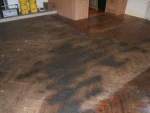
If you need to securely glue down a brand new wooden floor to a concrete underfloor, it goes without saying that the bond between the two surfaces needs to be strong if the concept is to work effectively. Bitumen, a substance that was commonly used as an adhesive in the 20th century, was initially regarded as the perfect solution for those who wanted to glue down a floor to an underlay quickly and efficiently – but these days, floor installers are recommending you steer clear from using this smelly, viscous material, as it can create all kinds of problems further down the line.
Read on to learn more about bitumen and its origins and why you should always remove it entirely if you find it underneath your old hardwood floor (instead of trying to bury it with a floor-levelling screed or compound, as many inexperienced DIY-ers still choose to do!).
What is Bitumen?
Bitumen, otherwise known as tar, was used commonly throughout the 50s, 60s and 70s as an adhesive to ‘glue’ parquet and other types of flooring to concrete.
Traditionally a type of residue from oil refineries, it is a thick, black, tar-like substance with a distinctive smell that has fulfilled a wide range of applications throughout history, yet it is best known for its use in the building and construction industries.
Why does it need to be removed from the underfloor?
When a floor is initially installed, bitumen seems to be a faultless adhesive. Aside from being an excellent natural glue, it’s resistant to the elements and entirely waterproof, which means it prevents moisture from seeping through into the subfloor and vice versa. It’s also a poor conductor of heat and electricity and so adds extra insulation properties to the floor.
However, floor installers quickly began to realise that using bitumen to glue a floor to its underlay presented them with a whole host of problems in the longer term. The substance actually turns incredibly brittle over time, which often causes the new floorboards to loosen. This affects the stability and performance of the floor. As bits of the old bitumen fall away and become suspended between the new floor and the old concrete floor, you’ll begin to hear irritating creaking sounds that seem to have no discernible source, an all-too-common scenario which often leads the homeowner to believe there’s something wrong with the floor itself!
A basic, step-by-step guide to removing Bitumen from a concrete base
For the above reasons, modern-day tradesmen recommend that you don’t prepare new floors over underlays that have been treated with bitumen. If you’ve recently ripped up your old hardwood floor to find a pesky layer of bitumen stuck to the concrete underlay underneath, here’s how to remove it with minimum fuss.
What you will need:
- Mineral spirits (the kind used to thin paint) – also known as white spirit or mineral turpentine
- A scrub or stiff brush
- A bucket
- Plenty of soap and water
- A mop and mop bucket
- Strong arms!
Step One: Use mineral spirits to lift off the tar. Mineral spirits, also referred to as turpentine, is a petroleum distillate that has many uses but is renowned for its pain thinning qualities. Pour the liquid onto the bitumen and you will see the tar begin to separate on the surface of the concrete. If you’re concerned about the flammability of the turpentine solution, feel free to add a little water to the mix to bring its volatility down.
Step Two: Elbow grease required! Using the brush, scrub the bitumen to break it up even further, being careful to dispose of flakes and debris as you go into a bucket or other kind of large container. This may take some time and can require a bit of effort (depending on the overall thickness of the layer) but it’s normally the most effective way of stripping back the bitumen.
Step Three: Repeat until there is no trace of the tar.
Step Four: Clean the surface. Use a mop and soapy water to mop up any lingering residue. Alternatively, use a wet dry vacuum to get rid of the remaining solution.
The Main Thing To Remember…
…Is that you should not under any circumstances simply place another layer of glue on top of the bitumen. Similarly, the concrete should not be re-screeded. The bitumen needs to be removed entirely before any other work is carried out for the best and longest-lasting results.
If this method isn’t doing the trick, we’d recommend asking a professional floor installer for advice!
Gareth North worked as a professional flooring installer before taking up a customer sales role at Essex-based flooring retailer Green Apple Flooring
